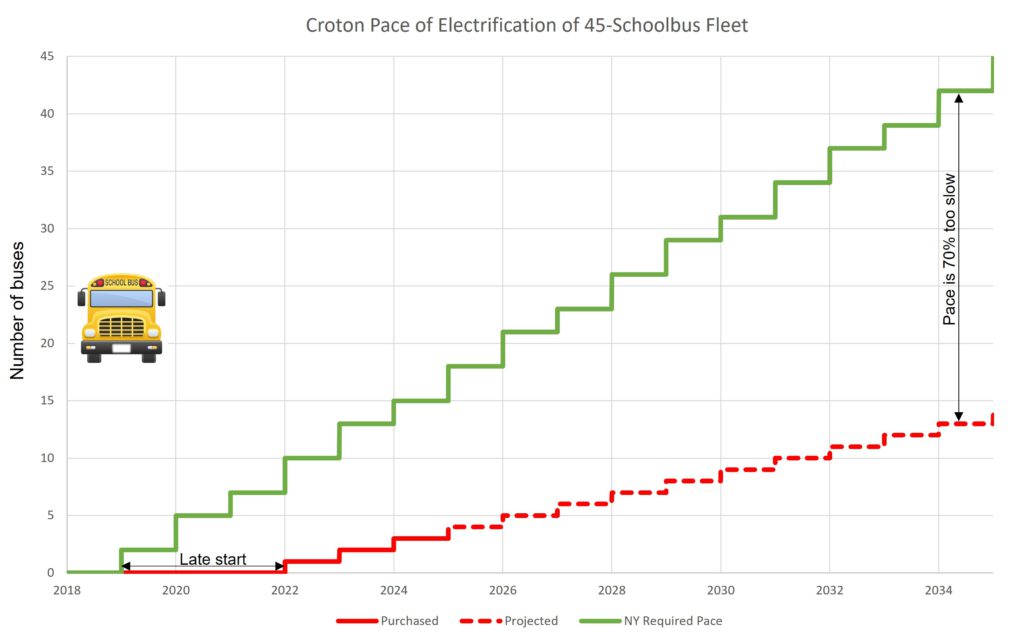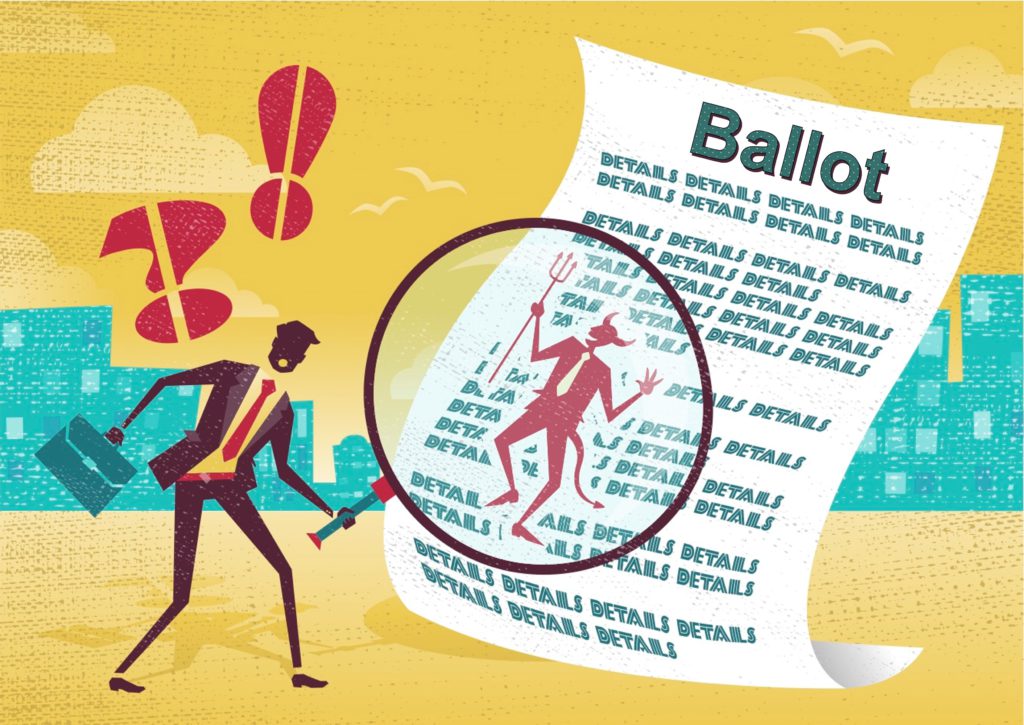
Meeting the Necessary Decarbonizing Pace: Small Steps in the Right Direction Are Not Enough
By: Patty L. Buchanan
The seasonal eco-grief that comes with school bus purchasing plans has, once again, set in. The stark truth is that the Croton School District continues to fall 70% behind the needed pace to meet NY State law and globally needed reduction in transportation greenhouse gas (GHG) emissions. The implications are best described by António Guterres, U.N. Secretary General when he said we’re on the “highway to climate hell with our foot still on the accelerator.”

If you live in a community where there has been some, little, or no progress on electric school buses, read on because Croton’s story is an important bellwether. The Croton School bus experience is also a microcosm of climate action that provides a model for translating global goals into local action.

In this ’23-24 School budget Vehicle Proposition which the community will vote upon on May 16, the Croton School proposes to buy the following vehicles for student transportation: one large (66 passenger) electric bus, one small (1-7 passenger) plug-in hybrid SUV, and one mid-size
(24-30 passenger) gas bus. Although the large e-bus and the plug-in hybrid are steps in the right direction, when viewed in context, this purchase plan falls far short of the decarbonizing action needed and includes some crafty greenwashing.
The above chart succinctly illustrates the GHG reduction hole we are digging by not moving faster to electrify the school’s transportation fleet of about 45 vehicles. Under NYS law, we need to have a fully electric fleet by 2035. The green steps in the chart illustrate that we should pace the transition to EVs by about 3-4 new EVs per year. The red line shows the Croton School’s actual purchases and proposed purchases in the coming years. Continuing this pace of adding one new electric bus per year leaves us far below the needed pace to achieve the necessary goal of a fully electrified fleet by 2035.

For each year that we fall short of the pace we need, in the years ahead we would have the daunting challenge of significantly increasing the EV purchases to make up for shortfalls from prior years. Accordingly, continuing to add fossil fuel buses to the fleet burdens future years with greater need to buy more EVs faster than ever before. In the meanwhile, it continues to increase emissions and particulate pollution. This slow start makes it unlikely that we will be able to catch up to have the required zero carbon fleet by 2035.

This stark illustration of the gap between the decarbonizing pace we are on, compared to the pace we need, is bewildering. On the one hand, we applaud the Croton School District for being a leader in school bus electrification, and as a community, we are proud that we are making progress. But the lack of diligence in grasping the scale of the transition needed and acting with corresponding pace is soul crushing. It gives cause for those who care about the urgency of climate action to oppose the School’s plans because they fall far short of needed action.

There’s a bit more of the “devil in the details” in this year’s Vehicle Proposition that will be on the May 16, 2023 ballot. At first glance, some people may be happy to see a plug-in hybrid is on the list of proposed purchases (it gives me a spark of joy!). A plug-in hybrid would drive about 30 miles on its electric motor, which is certainly better than a pure fossil fuel vehicle.
However, this short electric range does not meet the standard for a zero-carbon emitting vehicle because it is designed to run the balance of its miles on gas (in hybrid mode) each time its 30-mile electric charge is depleted. Thus, while this is a step in the right direction, we can and need to do better than the least worst fossil fuel vehicle option.
Digging more into the details: There is some crafty greenwashing in the Croton School Vehicle Proposition. The two electric golf carts (“low speed utility vehicles”) in Croton’s Vehicle Proposition are an enticing distraction from the hard task at hand. Electrifying vehicles in the School’s Operations is an important step in the right direction but including these $19,000 golf carts in the Vehicle Proposition is a spoiler tactic because they are not for student transportation. The golf carts will be used for Operations around the District Office and for transportation of disabled spectators at the School’s athletic field events. In a break from tradition, the School is expanding its Vehicle Proposition to cover vehicles other than the school buses that transport students in and around our school district. Also, these vehicles will have, at most, a modest carbon impact. Presumably, the School assumes voters will be enticed by the words “electric” and “plug-in” that appear in three of the four categories of proposed purchases, and thus voters will happily approve this bundled Vehicle Proposition. But this Vehicle Proposition leaves us 70% behind needed decarbonizing action and there does not appear to be any plan by the School to provide full disclosure to voters about this pace deficit.
Despite input to the contrary from stakeholders, the School has decided to prioritize electrification of the large, 66-passenger buses. Unfortunately, this strategy yields sub-optimal carbon reduction bang for the buck since these expensive buses drive mostly “in-district” and don’t rack up the kind of mileage some of the smaller buses do. The pace of decarbonization is best guided by a fleetwide carbon analysis that Croton100 has created and provided to the School.
It is important to understand that New York State’s law that requires all school buses be electric by 2035 is consistent with the IPCC’s call to achieve net zero emissions by 2040. The IPCC’s 2040 goal considers that some sources of greenhouse gas emissions are easier to eliminate than others. Vehicle transportation for example, is the low hanging fruit of decarbonizing actions because the fundamental technology is well understood, developed and accessible. Although purchase price and subsidies still require some navigating, this impediment is surmountable given recent federal and state legislative incentives and rapidly developing supply. Moreover, higher purchase prices of EVs are offset by lower total costs of ownership.
Achieving net zero emissions by 2040 means we must move especially fast on vehicle transportation because the more difficult sources of GHG such as large-scale transportation sectors like cargo shipping, air transport, as well as industrial manufacturing, steel and cement production will be harder to eliminate. These types of industries will be the carbon intensive tail that drags as we reach 2040.

The take-aways:
- We must translate IPCC carbon reduction standards to local action in quantified ways.
- It is not enough to take small decarbonizing steps. Enticing, yet insufficient action, amounts to greenwashing.
- Our actions must meet the pace and scale to achieve net zero by 2040 if we are to stave off catastrophic climate chaos.
- We need everyone to pay attention to how local taxpayer funds are continuing to support fossil fuel systems and to insist that expenditures keep pace with global scientific consensus of needed decarbonizing pace.
- We need voices of conscience in these perilous times, even when it is hard to make such voices heard.
- Voters should be given meaningful solutions on their ballots and should use their votes to reject a Proposition that does not align with their needs for stable climate systems.

